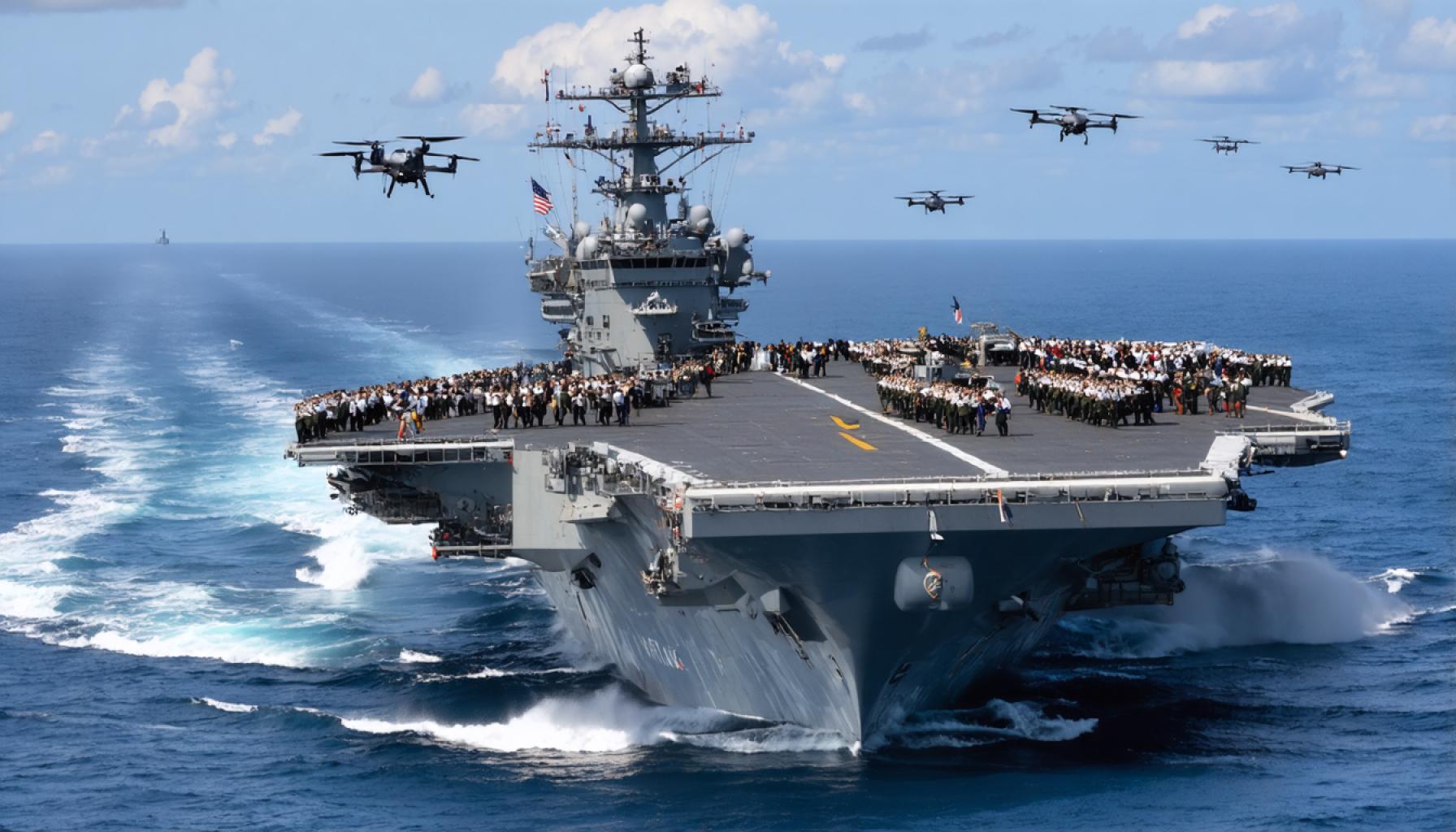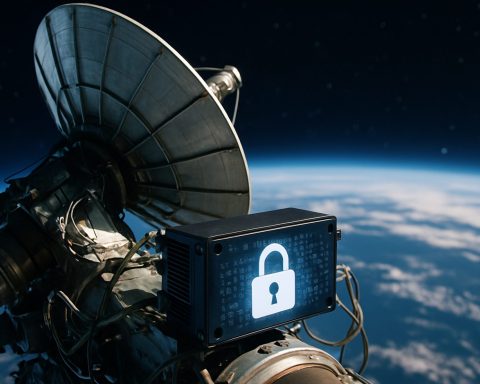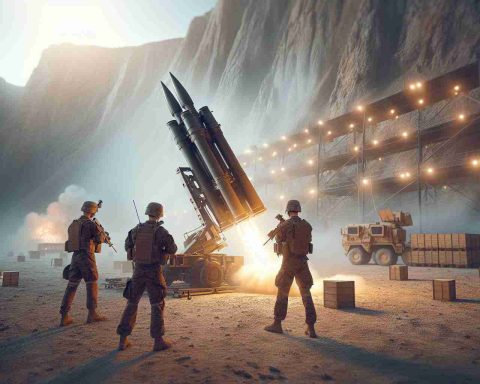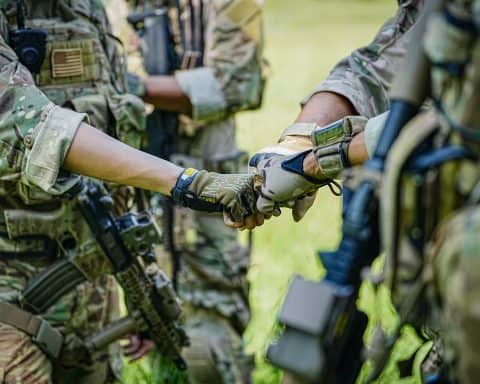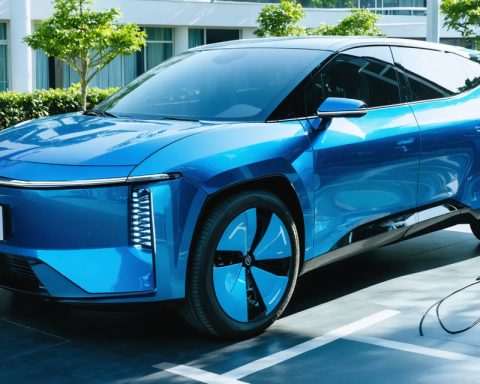- MQ-25 Stingray yra bepilotis orlaivis, sukurtas revoliucionuoti jūrinę aviaciją, papildant orlaivius ore iki 500 mylių nuo nešiklio, taip padidinant operacinį nuotolį.
- Planuojama, kad jis bus naslėtas 2025 m., MQ-25 žymi strateginį posūkį, integruojant pilotuojamas ir bepilotės sistemas, įkūnijant pažangiausias technologijas ir jūrinį prisitaikymą.
- Jūrų laivynas orientuojasi į bendradarbiavimą su Oro pajėgomis, dirbdamas su bendradarbiavimo kovos orlaiviais (CCA) dronais, skirtais tarpusavio, pritaikomam naudojimui su tokiais sistemomis kaip F-35 ir ateities naikintuvais.
- Bepilotų orlaivių, tokių kaip MQ-25, integracija nešikliuose kelia iššūkių, tokių kaip sudėtingos nusileidimo procedūros, kurios siekia pažanginti autonomines galimybes.
- Iniciatyva pabrėžia bepilotų sistemų valdymo svarbą, pozicionuodama dronus kaip esminius jūrų laivyno ateities kovos strategijų elementus.
Aboard the USS George H.W. Bush, under the steely gaze of experienced sailors, a sleek machine sits poised for a mission that promises to reshape naval aviation. This is the MQ-25 Stingray, an unmanned aerial vehicle destined to redefine how the U.S. Navy operates over the open sea. Scheduled to take flight in 2025, this drone tanker embodies a strategic shift that intertwines cutting-edge technology with naval tactical prowess.
At the sprawling Sea-Air-Space conference, voices of leaders and innovators filled the air with the possibilities of the future—one that envisions uniting manned and unmanned aerial vehicles into an indomitable force. Rear Adm. Michael “Buzz” Donnelly envisions a Navy where collaboration with the Air Force transcends mere strategic consultation; rather, it evolves into joint development of Collaborative Combat Aircraft (CCA) drones, which share the capabilities of interchangeability and adaptability.
Imagine a sky abuzz with the synchronized dance of fighter jets and drone wingmen—this is the Air Force’s growing reality as they advance semi-autonomous CCAs, designed to integrate seamlessly with the agile F-35 and the futuristic F-47 Next-Generation Air Dominance manned fighters. As the USAF pushes ahead having already unveiled two cutting-edge models, the Navy watches closely, ready to adopt and adapt these innovations for the unforgiving carrier environments.
For the Navy, the MQ-25 Stingray is not just a drone; it’s the vanguard, setting the nascent standard for a future where drones are as vital as their piloted companions. Built by Boeing under a substantial contract, the Stingray’s primary mission is to extend the operational range of jets like the F/A-18 Super Hornet, capable of refueling them in the heart of hostile airspace up to 500 miles away from the carrier.
Yet, the challenge extends beyond fueling fighters mid-air. As Adm. Donnelly describes, landing on a carrier is a „tight sequence of a ballet” amid the unpredictable chaos of the sea—a challenge exaggerated when involving unmanned aircraft. The MQ-25’s initial flights will provide critical insights, propelling the Navy toward a more autonomous future while leveraging the Air Force’s advancements in drone operations.
For admirals like Doug “V8” Verissimo, seeing the MQ-25 integrate with those who navigate the oceans daily comes with an optimistic outlook. This integration isn’t merely about technology. It’s about learning, adapting, and pushing the boundaries of what’s possible, paving the way for a combat fleet that can operate at the tactical edge.
This emerging alliance between airborne innovation and naval tradition captures a key takeaway: mastery of complex un-crewedsystems stands as a crucible for the modern Navy. As priorities and systems align across services, this new horizon beckons—one where uncrewed drones will no longer simply support, but rather spearhead, the American tactical fighting force across oceans, airways, and beyond.
Unlocking the Future of Naval Operations: The MQ-25 Stingray Revolution
Introduction
The USS George H.W. Bush, a symbol of naval prowess, now hosts one of the most anticipated advancements in naval aviation: the MQ-25 Stingray. This unmanned aerial vehicle (UAV), destined to take flight in 2025, signifies a groundbreaking shift in naval strategy, showcasing the synergy between cutting-edge technology and tactical acumen.
Diving Deeper into the MQ-25 Stingray
Features and Specifications
The MQ-25 Stingray, developed by Boeing, is designed to revolutionize aerial refueling capabilities. Its primary role is to extend the operational range of carrier-based aircraft such as the F/A-18 Super Hornet by serving as an aerial refueling platform. Key features include:
– Range and Endurance: The MQ-25 can refuel fighter jets up to 500 miles from a carrier, significantly expanding their operational reach.
– Autonomy: Advanced autonomous systems enable the MQ-25 to perform complex tasks with minimal human intervention.
– Compatibility: It integrates seamlessly with existing carrier operations and aircraft, ensuring flexibility and reliability.
Strategic Importance
The introduction of the MQ-25 Stingray marks a pivotal moment in the evolution of naval operations. By bridging manned and unmanned capabilities, the Navy can enhance operational efficiency and better respond to emerging threats. This innovation aligns with broader military trends, such as the Air Force’s development of Collaborative Combat Aircraft (CCA) drones.
How-To Guide for Naval Integration
1. Training and Simulation: Implement comprehensive training programs for naval personnel to adapt to the operational nuances of the MQ-25.
2. Infrastructure Upgrades: Enhance carrier systems to accommodate UAV operations, including takeoff, landing, and maintenance procedures.
3. Collaboration with the Air Force: Foster joint development programs to share insights and technologies, accelerating advancements in UAV capabilities.
Market Forecast and Industry Trends
– Increasing UAV Deployment: By 2030, the global military UAV market is expected to grow significantly, driven by technological advancements and evolving military needs.
– Focus on Interoperability: As military branches emphasize joint operations, investments in interoperable systems are poised to rise, facilitating integrated manned-unmanned missions.
Controversies and Limitations
While the MQ-25 represents a leap forward, challenges remain:
– Autonomous Operations: Ensuring reliable autonomous performance in unpredictable maritime conditions is critical.
– Budget Constraints: Balancing innovation with budgetary limitations continues to challenge military planners.
Security and Sustainability
– Cybersecurity: Protecting UAV systems from cyber threats is paramount. Ongoing investments in cybersecurity will safeguard sensitive data and operational integrity.
– Environmental Impact: As UAV technology evolves, there is a growing focus on minimizing environmental footprints, including fuel efficiency and emissions reduction.
Recommendations and Quick Tips
– Stay Informed: Keeping abreast of technological advancements in UAVs and military aviation is crucial for stakeholders and enthusiasts.
– Policy Advocacy: Support policies promoting joint research and development across military branches to ensure sustained innovation.
– Explore Career Opportunities: With the growth of UAV technologies, consider pursuing careers in aerospace engineering, cybersecurity, and military operations.
Conclusion
The MQ-25 Stingray embodies the future of naval operations, redefining how the U.S. Navy projects power over the seas. As technological and strategic landscapes evolve, the seamless integration of unmanned systems will dictate the future of military aviation. For more information on cutting-edge military technology and innovations, visit the U.S. Navy’s official website.
